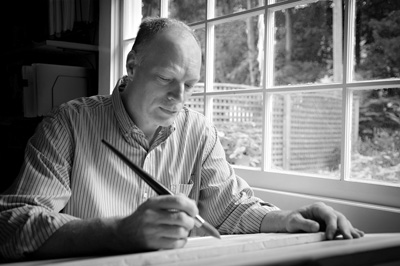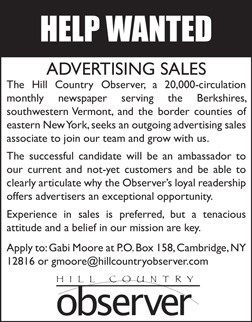Arts and Culture April 2015
From business to brushstroke
Painter’s art offers refuge from corporate world
 By TELLY HALKIAS
By TELLY HALKIAS
Contributing writer
BENNINGTON, Vt.
Tony Conner of Bennington, Vt., was working for an oil company in New Jersey in the 1980s when he set a goal of becoming a professional artist.
Courtesy photo
For Tony Conner, the road not taken was as clear as a lone printed word on a business memo pad.
In the 1980s, just a few years after completing his master’s degree in business administration, Conner was working for Tenneco Oil Co. in New Jersey when he attended a corporate seminar in Atlanta and found what he called his “Eureka moment of purpose and passion.”
It was the moment he realized that one day he would leave behind the white-collar world and march to a different tune.
“All of us in the room were asked to take an index card and write on it the thing we would do with our lives if we could do anything,” Conner said recently from his Bennington studio. “Out of 25 people, only two had written something that they could actually accomplish. I was one of those two and had written that I wanted to be an artist. I knew then that I would someday be a working artist, just wasn’t sure when that would be.”
Conner had painted as a hobby since elementary school, but he had missed out on formal art education in college. So he ventured forth to learn on his own, beginning a process of self-study that continues to this day.
While he was still working as a corporate sales and marketing executive, Conner began to carve out time from his day to set about the task of becoming a full-time artist. This included self-guided study and work as well as formal education and training when it fit his schedule.
“I couldn’t just drop everything in the midst of a growing family,” Conner said.
His wife, Jeanne, and their two children, both now college graduates, were supportive of his artistic efforts from the start, he said, “but we still had to be financially prudent.”
After relocating several times, the Conners settled in Bennington in 1989. At first Tony commuted to Albany daily to work at AT&T.
It was a period of his artistic development that Conner describes as “pursuing the dream while chained to the job.”
“I worked hard to bring my work to a professional level,” he said. “I painted as much as possible, at night and on weekends and when I had enough leftover energy. I also took classes and workshops regularly, including several from Frank Webb, who remains a great influence on my work. After my 1986 Eureka moment, it was clear that to become as good as possible as quickly as possible, I would need to focus on a single medium. Watercolor was the choice.”
Two years later, he landed his first entry into a juried art show.
“That was a double-edged sword, no doubt,” Conner said, smiling as he recalled his first taste of success. “Not only did my work get accepted to a show, which can be difficult, but the painting also sold afterwards, which sent my expectations sky-high.”
This early success stoked his impatience to shed business suits and become a full-time working artist. In 1995, Conner took his first major step in that direction by negotiating an extensive telecommuting provision into his workweek. This allowed him greater flexibility to pursue his painting, and it addressed his family needs as well.
After the Sept. 11 attack on the World Trade Center in 2001, Conner felt an even stronger resolve to reorient his life away from the corporate world.
“It was a terrible day, and it caused many people to think about things differently, as it did for me,” Conner said. “Then just over a year later, I was told my position had been eliminated and I would be given early retirement. Still, even though I had been preparing for the moment when I could pursue my art dream for more than 20 years, it was a terrifying prospect. March 27, 2003, was my last day on the AT&T payroll.”
New job, new skills
Immediately upon retirement, Conner attended the Boston Architectural Center and attained a certification as an advanced architectural renderer. The training gave him another medium for achieving commercial success, but he also credits it with giving new life to his representational work as an artist.
“It enhanced the vision and technique of my watercolors,” he explained.
One of his mentors in this process was Frank Costantino, an award-winning architectural draftsman based in Massachusetts -- and an artist in his own right.
Costantino said Conner has been a student, colleague and friend for more than a decade.
“When I first met him, he was changing his career from a corporate position to that of an architectural illustrator and watercolor artist,” Costantino said. “His commitment in following this course was sometimes frustrated and discouraging, but his was a relentless pursuit.”
Conner said he has taken numerous workshops run by Costantino and counts him as an influential adviser as well as an artist who taught him specific skills that carry into his work.
“Frank taught me the ability to translate color, color intensity and color temperature to depict the effect of light on form and on specific materials,” Conner said. “This is very important in an illustration that is supposed to depict a building that is constructed of specific materials, as it needs to look right. I also got a much better handle on managing the amount of water and pigment in washes to get effects more economically.”
It can be tempting, Conner added, to work hard in the studio and then passively wait for something to happen.
“I learned to believe in the power of active marketing and promotion,” he said. “It was clear that Frank worked hard not only to be the best watercolor artist he could be, but also to create opportunities for sales and commissions.”
Influences and honors
To get his watercolors to a point where Conner felt them worthy of gallery representation and sales, he regularly attended workshops and seminars by local and national artists.
He said Frank Webb and Philip Jamison have influenced his work, and another classic American master – John Singer Sargent -- also guides his hand.
“There are a number of things about the way he worked that I admire and find inspiring,” Conner said of Sargent. “He’s a master draftsman and painted his watercolors with great economy. He had the very rare ability to understand what simple shape, color or element would reveal a particular subject. I don’t know that I will ever achieve his level of skill, but I strive to do so.”
Robert Wolterstorff, an art historian who is director of the Bennington Museum, where Jeanne Conner also works, said Conner’s work stands in a long tradition of landscape painting in watercolor, and that Conner’s vision is what sets him apart from those who are drawn to his paintings.
“A really good landscape painter has learned to see the world differently from the rest of us,” Wolterstorff said. “Tony sees the blue in shadows and the purple in clouds where we see only gray. But then we say ‘Yes, he’s right, it really is that way!’ That is a revelation, and as a result we go out and see the world in a new way, enjoy it more, and understand our place in it differently. It changes us and enriches our lives.”
The motivation to strive for constant improvement while touching hearts seems to have served Conner well. His art, which emphasizes the rural landscape of New England, has been accepted frequently into regional shows, earning several honors.
In 2004, Conner won Best in Show at the Chaffee Center for the Arts in Rutland, and dozens of his paintings have sold to collectors nationwide. Recent honors include the Dorothy Yoder Award from the Vermont Watercolor Society, in June 2013, the Award for Excellence in Watercolor from the North Shore Art Association, in August 2012, and First Prize at the Billsboro Winery Plein Air Festival in Geneva, N.Y., in both 2010 and 2011.
And this year, Conner attained one of the highest honors for a working artist: membership in New York’s venerable Salmagundi Club. Founded in 1871, it’s a landmark institution for artists, and its membership once included greats such as N.C Wyeth and Louis Comfort Tiffany.
Shifting winds
Conner has made adjustments as a result of the changing economy. Although at one point he was represented by five galleries, he said his work soon will be out of any such venue.
“I’ve really spent the last five years creating my own exhibit opportunities and fostering increased sales online,” Conner said. “I’ve found that social media is a way to have people who like my work get to know me, a key factor in having them purchase a painting. Using a combination of social media, an active e-mail list and my own Web site, I’ve been able to generate good sales -- better than I’ve ever gotten from a group of galleries.”
But perhaps Conner’s most telling transformation as an artist is personal. Now, he’s become the mentor: He regularly offers classes, such as his popular summer evening outdoor painting courses.
And although he is still always working to improve his skills, Conner has learned to relax his grip on rigor and discipline, the proven method through which he says he transforms his inspiration into art. He now empathizes with the more leisurely yet instinctive appreciation of his established and still-growing fan base.
“My drive for technical perfection, which is one of my strengths and a carryover from my business years, was also my downfall at times,” Conner said. “I was harshly critical of my work, often causing extended periods of creative block. But now I realize I have a better handle on that aspect of the craft, so I worry more about the expression of the moment.”
Conner added that after he started receiving feedback from those who saw his watercolors and who bought them, he was humbled to learn what powerful emotions art invokes in its beholders.
“In the end, most people appreciate beauty over brushstroke,” he said.


